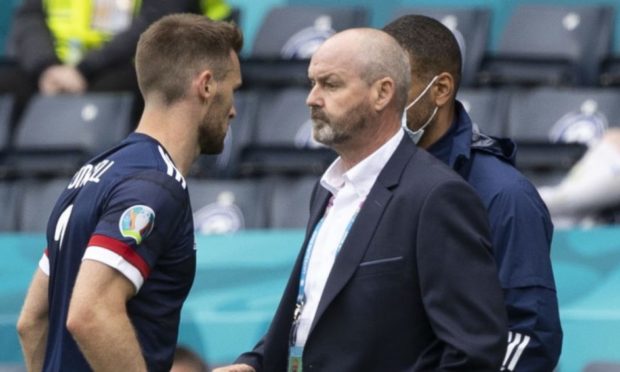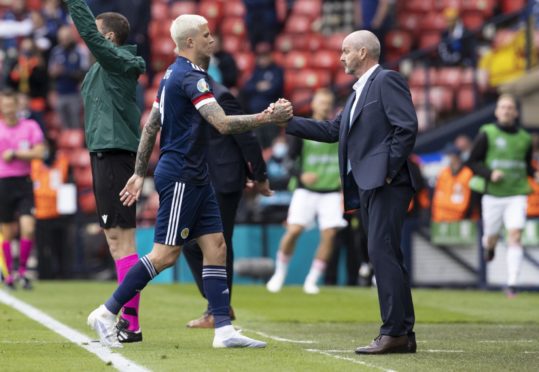Given the fact Scotland have now been at nine major tournament finals and in only two of them have they started with a win (against group minnows on both occasions), you would expect there to be a precedent for what happened on Monday afternoon and what now has to happen on Friday night at Wembley.
The closest one feels like the first game defeat of Italia ’90.
Czech Republic are a far superior team to the Costa Rica side that humiliated Andy Roxburgh’s men in Genoa but the comparison of Scotland managers getting their team selections and tactics all wrong is a valid one.
Roxburgh inexplicably opted for Alan McInally up front and a strategy of bludgeoning his technically efficient opponents with a team of giants in the hot summer sun and now Steve Clarke has taken a leaf out of his book by leaving Che Adams on the bench and by-passing midfield to get to Lyndon Dykes in one long pass.
Four starting XI alterations were made in 1990 from Costa Rica to Sweden, with Craig Levein, Murdo MacLeod, Robert Fleck and Gordon Durie playing their part in a famous bounce-back victory for the Scots.
Eric Nicolson looks at the changes Clarke should be thinking about as he attempts to emulate Roxburgh and get the Euro 2020 Group D campaign back on the rails at Wembley and goes one further than 31 years ago, opting for FIVE this time around.
DEFENCE – TWO CHANGES
Working on the basis that Kieran Tierney is fit and available for selection, Clarke will get the ball-playing defender he needs to make his 3-5-2 formation work properly.
Jack Hendry should have been that man against the Czech Republic but made little to no meaningful impact on getting Scotland up the pitch through midfield.
Tierney’s return means Clarke can go with the two traditional, no-frills centre-halves alongside him.
Kieran Tierney is back in #SCO training ahead of their clash with #ENG on Friday pic.twitter.com/lfdPsxjgHn
— Sky Sports Scotland (@ScotlandSky) June 15, 2021
As such, Grant Hanley and Liam Cooper keep their places on the right side and middle of the three respectively.
As a lot of us feared and predicted, Stephen O’Donnell’s limitations as an international right-back were brutally exposed.
It’s got to the stage where throwing in a rookie like Nathan Patterson doesn’t even represent a gamble anymore.
If not him then it has to be James Forrest.
Either way, putting O’Donnell up against Raheem Sterling or Jack Grealish simply doesn’t bear contemplation.
Clarke should resist calls to swap David Marshall for Craig Gordon, however.
MIDFIELD – ONE CHANGE
There is substantial mitigation for the English Premier League regulars Stuart Armstrong, Scott McTominay and John McGinn having at best OK performances on Monday afternoon.
That the ball was sailing over their heads far too often in the first half is at the top of the list.
But even in those circumstances, and as good as they all are individually, it didn’t feel like a balanced trio and so it proved.
That balance would be restored with Billy Gilmour replacing Armstrong.
Okay, okay, so 🏴 Scotland lost to the Czechs 🇨🇿.
But with 🏴 Engand to come on Friday, @SeanHamSport and @RyanCryle were joined by Craig Brown and @Charlie26Adam to look ahead to Wembley.
SPOILER ALERT: Scotland's Euro 2020 is NOT over.
Watch: https://t.co/Rg0HAb9fh5 pic.twitter.com/CgZe2YTkFL
— The Courier Sport (@thecouriersport) June 15, 2021
I do fear that it will be Callum McGregor for the former Dundee United man, though.
After all, Clarke made five substitutions against the Czechs and Gilmour wasn’t among them.
There is also the chance that Clarke drops McTominay back into defence, of course, in which case it should be Gilmour, McGinn and Armstrong.
ATTACK – TWO CHANGES
This is where Clarke was most culpable for that disjointed first half display on Monday.
Lyndon Dykes was his Alan McInally.
Dykes proved to be of very limited use and having an established elite striker like Che Adams kept on the bench was folly.
While the QPR forward undoubtedly improved with Adams near to him in the second half, he would struggle to make any sort of impact against England’s central defenders.
Scotland require more subtlety.
Adams with Ryan Fraser, in for Ryan Christie, just off him has the potential to drag those centre-halves out of position and allow McGinn and McTominay to drive through the middle far more effectively than they were able to do at Hampden against the Czechs.

